It looks like you're using an Ad Blocker.
Please white-list or disable AboveTopSecret.com in your ad-blocking tool.
Thank you.
Some features of ATS will be disabled while you continue to use an ad-blocker.
share:
originally posted by: markymint
It's pay walled but here is the Florida Today issue with apparently the Air Force reply:
floridatoday.newspapers.com...
And I have always wondered, what IS this "flare" procedure the military do and what is its practical application? I can understand doing it at night perhaps, to light up a submarine. But in sunlight? Go several miles out to sea just to drop some flares and bugger off? For a routine that seems never to be used outside of when there's a UFO sighting?
Are flare drops rife at airshows? No (edit, ok they are more commonplace in the USA, not here in the UK tho, not that we really do the "it was flares" thing here in the UK with UFOs though). Do you see flare drops in Iraq/Afghan war footage? No. Do helicopters drop flares in civil situations ie emergencies or police incidents? No. Do your local air bases generally do flare dropping routines? No. is there footage from WW2 of flares? Not that I know of. So what on gods green earth is the practical application for which they are doing the "test" ?? Other than to be a convenient distraction to UFO claims. The closest practical application I can think of is napalm and that Vietnam war photo... Please fill me in though, give me reason to believe their is some purpose in a flare dropping "exercise"...
Flares surely have to signify a static event. Something to illuminate. Military jets + flares seems like a very awkward sum. They have night vision and targetting systems and they don't seem to spend much time in one place so the practical application there just seems...dumb. Alternatively, why would you fly some helicopters out to the ocean (if we take the flare route with the video in this thread) and not stick around, what is the point of "just dropping flares"? Honestly, I don't think it's a real exercise anymore. Sure A helicopter might do a test of dropping A flare but anything outside of that just seems stupid. Apply the same thing to Phoenix Lights. Let's drop some flares in a pretty line way above anything for them to illuminate because this is something we often do and apply in air force tactics...NOT.
And pilots and personnel and all those stories they have about flare dropping exercises...oh wait... Not to mention the footage of actual flare drops...
What's that, the light source is visible only briefly, yet plumes of smoke are visible for ages? And they drop very quickly? Presumably a one off, cos from this UFO video we know that flares stay brightly lit for 1 minute and don't drop in altitude.
Oh nope, that looks like more momentary brightness and more plumes of smoke filling the sky after a flare drop. And there was me thinking flares stay lit about 50 feet off the water for whole minutes at a time..!
Maybe night exercizes are different?
Oh no, it seems they're not different at all. Same momentary source of light that dissipates within a few seconds So we have special types of flares for Phoenix Lights and Indialantic? Hyper flares or something that can hold altitude and don't burn out? Can someone elaborate on this type of flare please?
for anybody in this thread who is either semi or all the way convinced that these are military flares in the video, please pay close consideration to this post above.
a reply to: wmd_2008in the vietnam era, flares smoked like a mother bear.....so to can clearly see dark smoke pouring in the
daytime and at night it looks like a runaway hamburger cookout left unattended
that vid is not flares.....gravity has no effect on them and they're too bright....with an apparent diameter three times too big for magnesium fire
jets drop chaff flares for avoidance.....not the same.....
that vid is not flares.....gravity has no effect on them and they're too bright....with an apparent diameter three times too big for magnesium fire
jets drop chaff flares for avoidance.....not the same.....
edit on 30-12-2017 by GBP/JPY because: (no reason given)
Looks like some of these lights aren't stationary:

... with even two that disappears at the extreme right.

... with even two that disappears at the extreme right.
edit on 30-12-2017 by elevenaugust because: (no reason given)
originally posted by: wmd_2008
a reply to: facedye
Easy to solve go to youtube look at videos posted on channel have a good laugh then leave.
Everything posted is supposed to be evidence more like BS.
this comment adds zero intellectual value to this discussion. we're talking about the footage, not the youtube uploader. that's not where the footage came from.
edit on 30-12-2017 by facedye because: (no reason given)
originally posted by: elevenaugust
Looks like some of these lights aren't stationary:
... with even two that disappears at the extreme right.
ok, so what are you trying to say?
if you paid close attention to what they were saying, the cameraman stated that there were 7 of them just before he started filming, and that some of them disappeared, then reappeared.
let's be clear about something - they're not dropping like flares, and they do not look like flares. they also do not resemble any oil rig in the distance i've ever seen.
you seem skeptical, and convinced. can you show me any man-made or natural earthly process that looks like this?
You first have to realize this isn't a continuous shot and the video is edited. At :22 it starts at the beginning again. So you need to watch the
video starting at :22 until it ends at 1:45 -- This is the full uncut shot. When you do, watch the group of flares on the right, obviously the
first group that was dropped. It begins as 4 lights:
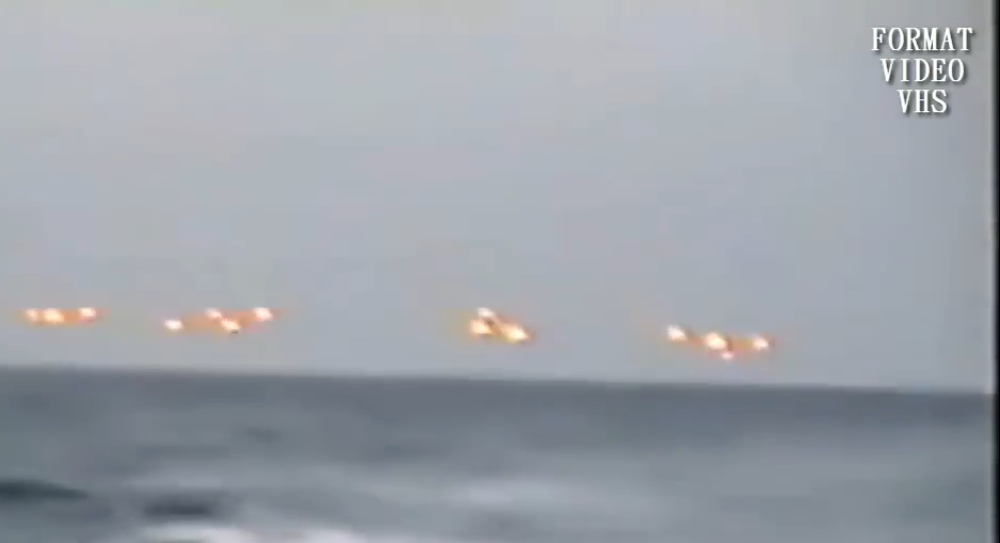
As you watch the video the 4th light fades out:
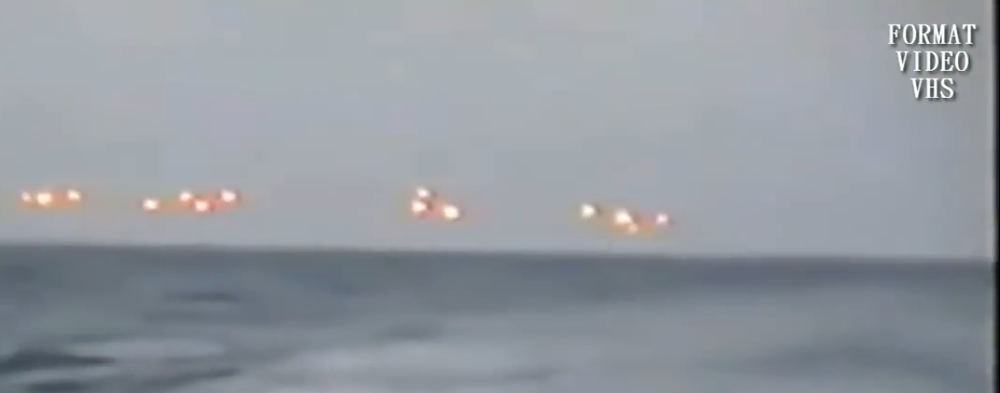
Now we're left with 3 flares:
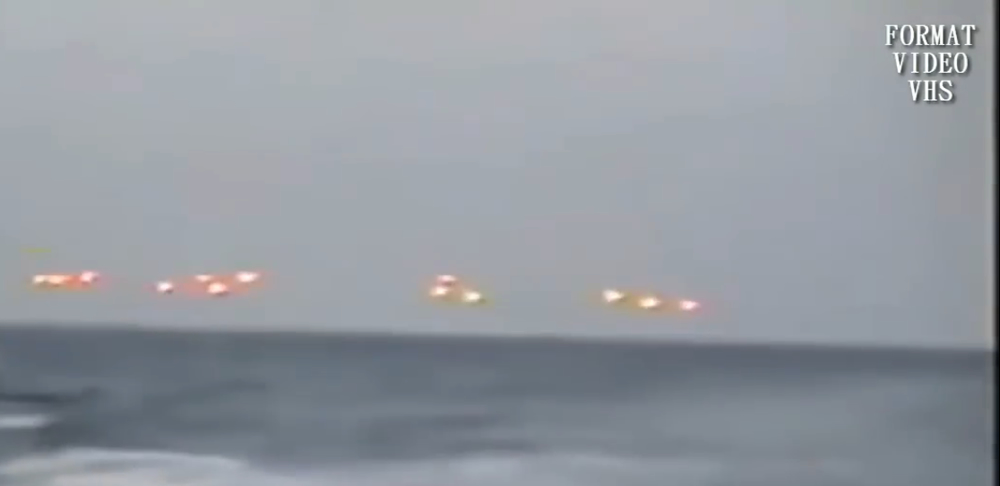
The 3rd flare begins to fade out:
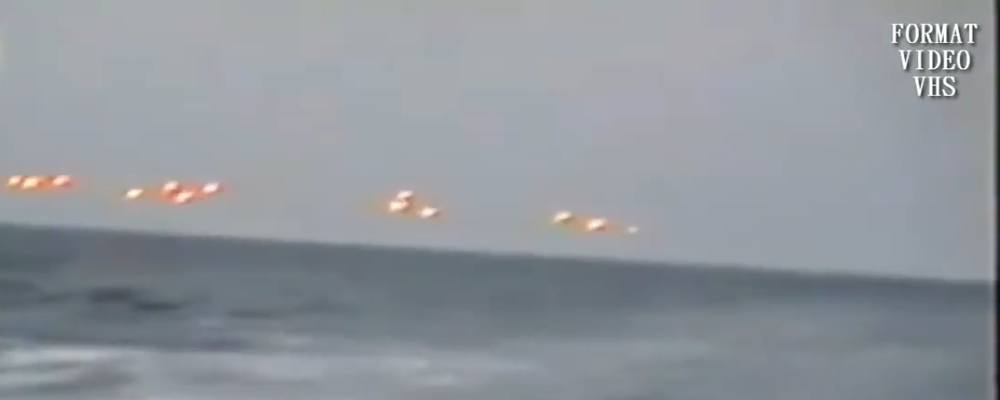
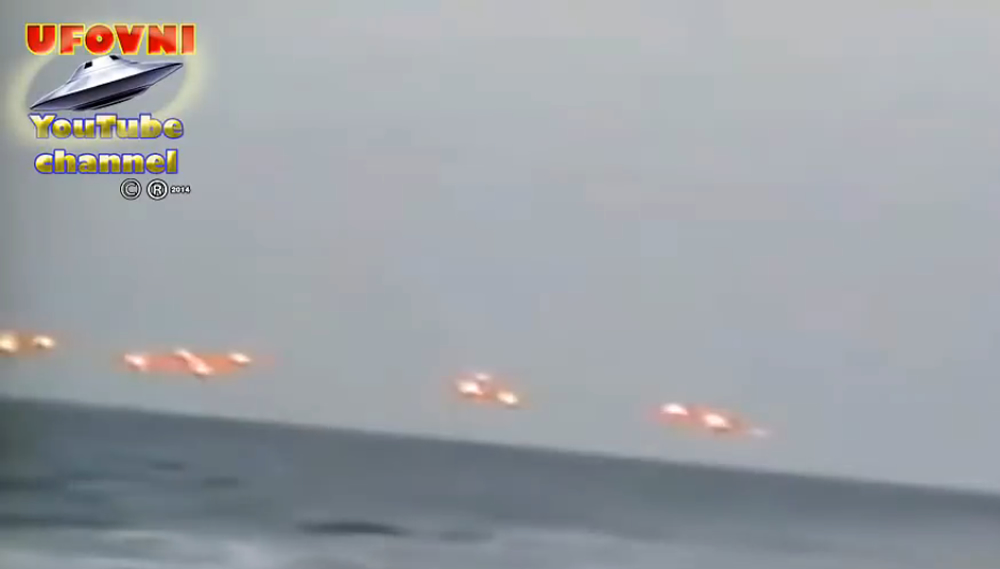
Now we're left with 2 flares:
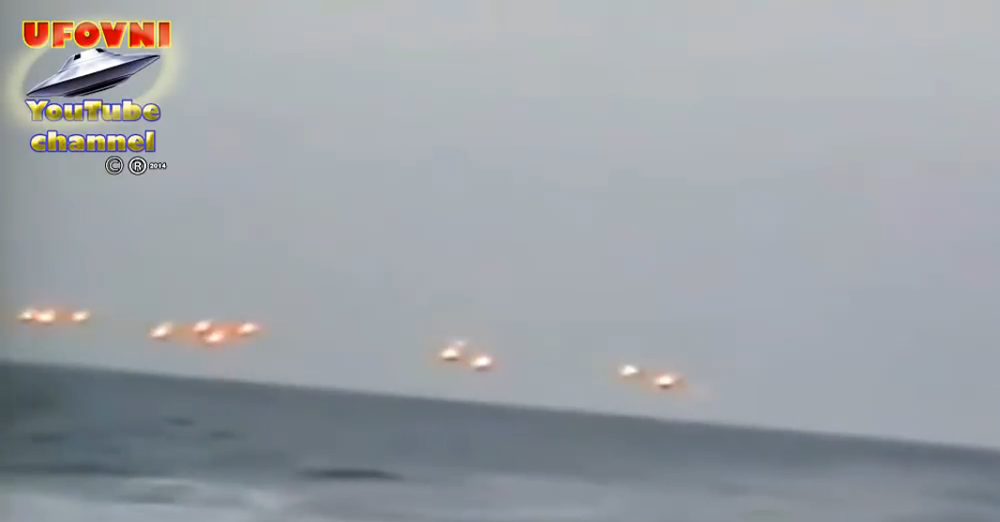
The 2rd flare begins to fade out:
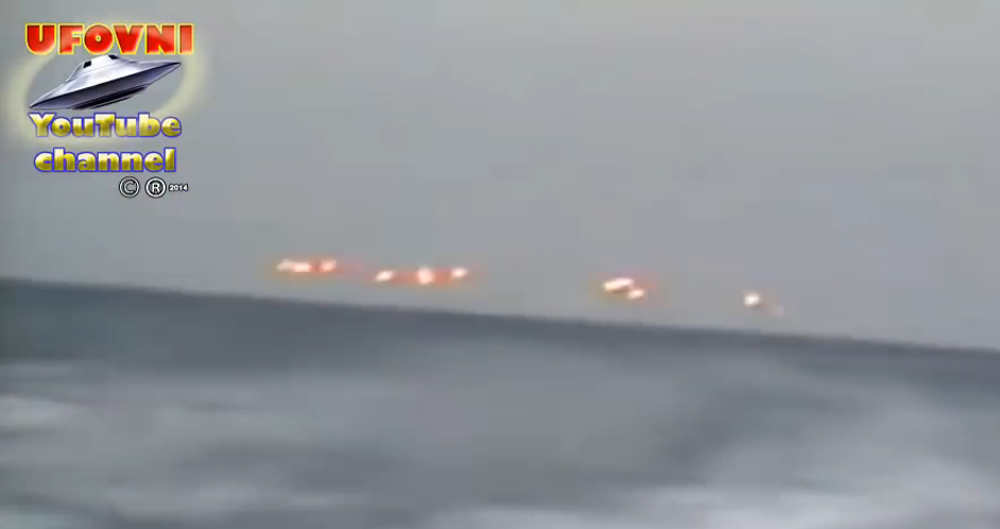
Now we're left with 1 flare:
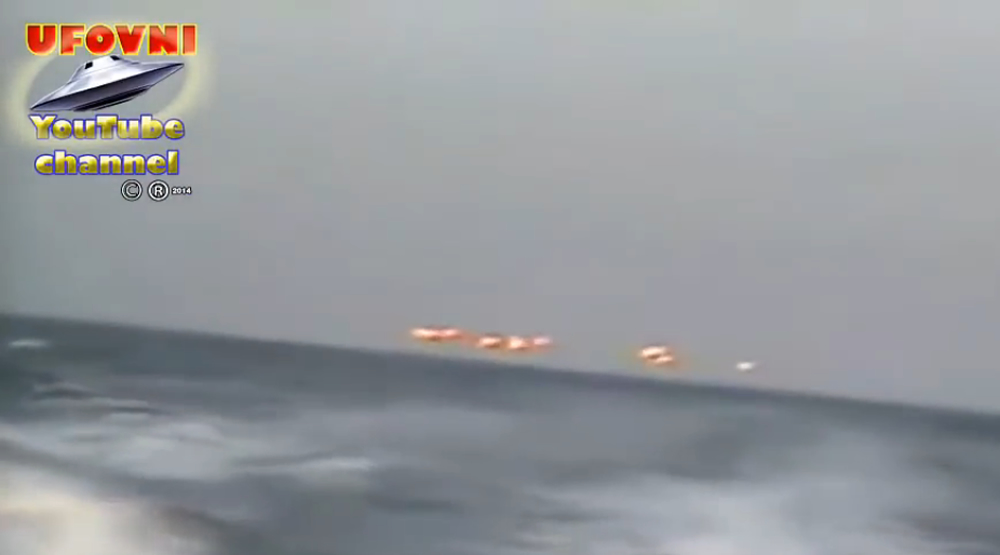
The video ends shortly thereafter. The lights are acting exactly as dropped flares would.

As you watch the video the 4th light fades out:

Now we're left with 3 flares:

The 3rd flare begins to fade out:


Now we're left with 2 flares:

The 2rd flare begins to fade out:

Now we're left with 1 flare:

The video ends shortly thereafter. The lights are acting exactly as dropped flares would.
originally posted by: Ectoplasm8
You first have to realize this isn't a continuous shot and the video is edited. At :22 it starts at the beginning again. So you need to watch the video starting at :22 until it ends at 1:45 -- This is the full uncut shot. When you do, watch the group of flares on the right, obviously the first group that was dropped. It begins as 4 lights:
As you watch the video the 4th light fades out:
Now we're left with 3 flares:
The 3rd flare begins to fade out:
Now we're left with 2 flares:
The 2rd flare begins to fade out:
Now we're left with 1 flare:
The video ends shortly thereafter. The lights are acting exactly as dropped flares would.
no, they're not dropped exactly like flares. show me another example please. also, turn your attention to the very first post on this page, which just so happens to be my reply to marky's wonderful write up - that's what flares look like.
EDIT:
i mean.. really..
^^^ those are flares. flares show up brightly, fizzle out quickly, and are ***always in a state of descension***
think the footage in my OP is just nothing more than a bunch of flares? great, in that case it should be really easy to prove - please show us one example.
edit on 31-12-2017 by facedye because: (no reason given)
a reply to: facedye
You're allowing your belief and conviction these are anomalous objects to cloud your judgment. You begin with a rational grounded explanation first and work your way outward from there. Not the opposite end and try to prove they're not.
Not only do we have the Air Force giving a statement in Florida Today that the military was dropping flares in the area that day, but we have video. The video only supports that statement. You see a group of 4 lights on the right that slowly flicker out and disappear ending up with a single light. Military parachute flares will hover and fade out when the chemicals in the canister are burned up. The flares in the video also fade in succession from right to left as you'd expect a group of flares dropped from aircraft flying left to right across the horizon. There's no mechanical shutting off of the lights or the lights zipping away showing some type of intelligent control. They simply and naturally flicker out.
The military uses flares for various reasons. Below is one example of an aircraft launched flare and the properties when burning:
Source
As shown in the video with the flickering out, it's logical to conclude that they were at the end of their drop where the aluminum housing was being burned giving off the orange hue while the decent was slowed giving the appearance of the flares hovering or being stationary.
So here we have visual examples above showing the lights don't just disappear they fade, combined with a description by the manufacturer of how certain flares hover and burn out. To me, this is a rational explanation for what is seen in the video. Far better than a UFO.
You're allowing your belief and conviction these are anomalous objects to cloud your judgment. You begin with a rational grounded explanation first and work your way outward from there. Not the opposite end and try to prove they're not.
Not only do we have the Air Force giving a statement in Florida Today that the military was dropping flares in the area that day, but we have video. The video only supports that statement. You see a group of 4 lights on the right that slowly flicker out and disappear ending up with a single light. Military parachute flares will hover and fade out when the chemicals in the canister are burned up. The flares in the video also fade in succession from right to left as you'd expect a group of flares dropped from aircraft flying left to right across the horizon. There's no mechanical shutting off of the lights or the lights zipping away showing some type of intelligent control. They simply and naturally flicker out.
The military uses flares for various reasons. Below is one example of an aircraft launched flare and the properties when burning:
Air-deployed LUU-2 flare high intensity illumination flare are used to illuminate targets. The LUU-2B flare has a light output rating of 1.8 x 10(6) candlepower and at 1000 feet altitude illuminates a circle on the ground of 500 meters at 5 lux. The LUU-2 is housed in a pod or canister and is deployed by ejection. The mechanism has a timer on it that deploys the parachute and ignites the flare candle. The flare candle burns magnesium which burns at high temperature emitting an intense bright white light. The consumption of the aluminum cylinder that contains the flare "candle" may add some orange to the light.
The LUU-2 has a burn time of approximately 5 minutes while suspended from a parachute. The pyrotechnic candle consumes the flare housing, reducing flare weight which in turn slows the rate of fall during the last 2 minutes of burn time.
Source
As shown in the video with the flickering out, it's logical to conclude that they were at the end of their drop where the aluminum housing was being burned giving off the orange hue while the decent was slowed giving the appearance of the flares hovering or being stationary.
So here we have visual examples above showing the lights don't just disappear they fade, combined with a description by the manufacturer of how certain flares hover and burn out. To me, this is a rational explanation for what is seen in the video. Far better than a UFO.
edit on
31-12-2017 by Ectoplasm8 because: (no reason given)
originally posted by: Ectoplasm8
a reply to: facedye
You're allowing your belief and conviction these are anomalous objects to cloud your judgment. You begin with a rational grounded explanation first and work your way outward from there. Not the opposite end and try to prove they're not.
Not only do we have the Air Force giving a statement in Florida Today that the military was dropping flares in the area that day, but we have video. The video only supports that statement. You see a group of 4 lights on the right that slowly flicker out and disappear ending up with a single light. Military parachute flares will hover and fade out when the chemicals in the canister are burned up. The flares in the video also fade in succession from right to left as you'd expect a group of flares dropped from aircraft flying left to right across the horizon. There's no mechanical shutting off of the lights or the lights zipping away showing some type of intelligent control. They simply and naturally flicker out.
The military uses flares for various reasons. Below is one example of an aircraft launched flare and the properties when burning:
Air-deployed LUU-2 flare high intensity illumination flare are used to illuminate targets. The LUU-2B flare has a light output rating of 1.8 x 10(6) candlepower and at 1000 feet altitude illuminates a circle on the ground of 500 meters at 5 lux. The LUU-2 is housed in a pod or canister and is deployed by ejection. The mechanism has a timer on it that deploys the parachute and ignites the flare candle. The flare candle burns magnesium which burns at high temperature emitting an intense bright white light. The consumption of the aluminum cylinder that contains the flare "candle" may add some orange to the light.
The LUU-2 has a burn time of approximately 5 minutes while suspended from a parachute. The pyrotechnic candle consumes the flare housing, reducing flare weight which in turn slows the rate of fall during the last 2 minutes of burn time.
Source
As shown in the video with the flickering out, it's logical to conclude that they were at the end of their drop where the aluminum housing was being burned giving off the orange hue while the decent was slowed giving the appearance of the flares hovering or being stationary.
So here we have visual examples above showing the lights don't just disappear they fade, combined with a description by the manufacturer of how certain flares hover and burn out. To me, this is a rational explanation for what is seen in the video. Far better than a UFO.
i asked you to provide an example that these are flares in a very straightforward way, and you have chosen not to do so.
instead, you start talking to me about how i'm entrenched in my own beliefs, and then assert that these lights in the footage had parachutes. do you see any parachutes? no, you don't.
you also don't know my beliefs - i'm simply stating that these aren't flares, and you yourself can't prove that they are. i've given you many examples to show you the difference. you have only provided conjecture.
EDIT:
parachute flares, really easy to find:
you probably didn't wanna post any footage because it looks exactly like that, which looks nothing like the footage in my OP.
i couldn't find a specific example for the LUU-2 you mentioned, but i did find an example of an LUU-19:
and again.. this doesn't resemble the footage in my OP by any means.
so.. is it me who is entrenched in my beliefs here, or is it you?
edit on 31-12-2017 by facedye because: (no reason
given)
a reply to: facedye
You're basing an argument on the fact there are no videos of a launch of a small grouping of LUU-2 flares from 20 miles away over water recorded on a shaky 23+ year old video tape camera during the last 2 minutes of the flare drop to relate it to? The digital recorded YouTube videos you're showing are irrelevant and pointless to the specific flare I mentioned, i.e. a flare that can stay suspended and lit for 5 minutes via parachutes, turns an orange hue towards the end of their drop, and slows the decent the last 2 minutes which would give the illusion of of little to no movement. This actually counters your argument that flares "fizzle out quickly and are always in a state of descension." Clearly you didn't do your research.
You honestly believe a low quality video tape camera from the early 90s with no obvious stabilization capabilities is able to record small flare parachutes from 20 miles away? The guy recording can hardly keep the camera steady enough at the wide angled shot of the video much less any close shots.
The many examples of flares you've given aren't close to the LUU-2 flare I mentioned. You're showing the typical flares launched in large numbers. For example: 38mm parachute 30,000 candle power flare with a launch height of 1150 feet and a 40 second burn/illuminating time - 45 mm parachute flare 300,000 candle power decent time 5 meters a second, burn time 25 seconds, etc. As I stated previously, there are many different military flares used. You're choosing the wrong ones for your argument.
"Conjecture" is providing individual video frames showing how the lights fade and flicker out -- as flares do? Showing how the lights progressively fade from right to left -- as air-launched flares would do? Conjecture is quoting and linking a military flare with a description by the manufacture that support the exact actions of the lights in the video -- as these flares? Conjecture is the article the next day in the local paper with the Air Force saying flares were being dropped by military aircraft in the area that same day?
Just curious what you believe here. Where was the separate second sighting of the Air Force flares? They just happened to coincide with the UFO sighting? Or maybe the military response is just part of the believer great government conspiracy mantra?
Sorry, but I yet to see you provide anything other than a personal opinion. According to your first post, it seems to come down to a feeling you have that the person reporting this incident is doing so as part of disclosure, has some type of insider knowledge, or some other type of ~woo~woo~ mysterious involvement. You also naively give some kind of weight to the MUFON comment "same configuration we've been seeing for the past hundred thousand years" from an anonymous person on the web. That's an example of the weak level of convincing you require?
Can you show me in the video where the lights perform unexplainable maneuvers or do something that shows these are anomalous objects rather than this coming from a personal feeling you have? Give me a logical explanation for the lights fading and going out. Alien rheostat lighting?
I asked you to provide an example that these are flares in a very straightforward way, and you have chosen not to do so.
You're basing an argument on the fact there are no videos of a launch of a small grouping of LUU-2 flares from 20 miles away over water recorded on a shaky 23+ year old video tape camera during the last 2 minutes of the flare drop to relate it to? The digital recorded YouTube videos you're showing are irrelevant and pointless to the specific flare I mentioned, i.e. a flare that can stay suspended and lit for 5 minutes via parachutes, turns an orange hue towards the end of their drop, and slows the decent the last 2 minutes which would give the illusion of of little to no movement. This actually counters your argument that flares "fizzle out quickly and are always in a state of descension." Clearly you didn't do your research.
...and then assert these lights in the footage had parachutes. do you see any parachutes? no, you don't.
You honestly believe a low quality video tape camera from the early 90s with no obvious stabilization capabilities is able to record small flare parachutes from 20 miles away? The guy recording can hardly keep the camera steady enough at the wide angled shot of the video much less any close shots.
i've given you many examples to show you the difference.
The many examples of flares you've given aren't close to the LUU-2 flare I mentioned. You're showing the typical flares launched in large numbers. For example: 38mm parachute 30,000 candle power flare with a launch height of 1150 feet and a 40 second burn/illuminating time - 45 mm parachute flare 300,000 candle power decent time 5 meters a second, burn time 25 seconds, etc. As I stated previously, there are many different military flares used. You're choosing the wrong ones for your argument.
you have only provided conjecture.
"Conjecture" is providing individual video frames showing how the lights fade and flicker out -- as flares do? Showing how the lights progressively fade from right to left -- as air-launched flares would do? Conjecture is quoting and linking a military flare with a description by the manufacture that support the exact actions of the lights in the video -- as these flares? Conjecture is the article the next day in the local paper with the Air Force saying flares were being dropped by military aircraft in the area that same day?
Just curious what you believe here. Where was the separate second sighting of the Air Force flares? They just happened to coincide with the UFO sighting? Or maybe the military response is just part of the believer great government conspiracy mantra?
Sorry, but I yet to see you provide anything other than a personal opinion. According to your first post, it seems to come down to a feeling you have that the person reporting this incident is doing so as part of disclosure, has some type of insider knowledge, or some other type of ~woo~woo~ mysterious involvement. You also naively give some kind of weight to the MUFON comment "same configuration we've been seeing for the past hundred thousand years" from an anonymous person on the web. That's an example of the weak level of convincing you require?
Can you show me in the video where the lights perform unexplainable maneuvers or do something that shows these are anomalous objects rather than this coming from a personal feeling you have? Give me a logical explanation for the lights fading and going out. Alien rheostat lighting?
edit on 1-1-2018 by Ectoplasm8 because: (no reason given)
a reply to: Ectoplasm8
i think you misunderstood your own source - are you reading through your own material intently before posting replies sourcing it?
from your link:
"The LUU-2 has a burn time of approximately 5 minutes while suspended from a parachute. The pyrotechnic candle consumes the flare housing, reducing flare weight which in turn slows the rate of fall during the last 2 minutes of burn time."
the rate of fall slows for the last 2 out of the 5 minutes of its deployment. that means it constantly looks like it's falling, with considerable amount of smoke following it, just slower. i've shown you similar LUU models with parachutes, similar to the one the LUU-2 has, and somehow you conveniently render it "meaningless."
the specific flare you mentioned is highly similar to the LUU-19 i presented - you're literally looking at a modification of the same series of flares. from your own sourced website:
LUU-19 Flare Details
also, as you can plainly see, it has a burn time of about 7 minutes overall. i'm sorry to burst your bubble, but the comparison between an LUU-19 and an LUU-2 is anything but meaningless. they're similar flares, and they look like the videos i posted. don't think so? please show me something other than your word as an example.
you honestly believe the flares would look that bright 20 miles away on a "low quality video tape camera from the early 90's"? on top of that, you also believe that this kind of low quality camcorder would be able to capture lights like that 20 miles away, but not their smoke trails or parachutes? you're going to have to validate your solution on that one, because that math truly doesn't make any sense.
this is a blatant appeal to authority. not only that, but you're dismissing the inconsistencies in the information i posted in my OP. there's some depth to this portion that you're unwilling to entertain.
i've provided sources, comparisons, related information, counterpoints and my own analysis. if my opinion can be observed within this effort, then i'm sorry to tell you that i have that right. why does that bother you so much?
did you not read the NYT article that came out on the 16th of last month? the official public government position on UFOs has been exactly the one you seem to be taking since the 40's-50's, that of staunch pessimism and sarcasm. the funny part about that is, they basically admitted to using that position as a cover to actually study the phenomenon at great lengths.
you seem to not only be appealing to authority, but also disengaging yourself from how they're suddenly no longer appealing to your position. the military lies sometimes. i don't know why you find that to be so unbelievable.
meh, you're misunderstanding me. i cited that quote of his to say that this is a reason we shouldn't be taking that MUFON report seriously, nor at face value at all. it seemed ridiculous to me, and that's why i mentioned it. i'm not convinced either.
"lights fading and going out" is a commonly reported characteristic of UFO sightings. i'm simply saying that they don't look like flares, and they don't look like oil rigs. maybe if you assumed less about the person you were responding to, you'd find less reason to act on your impulses.
The digital recorded YouTube videos you're showing are irrelevant and pointless to the specific flare I mentioned, i.e. a flare that can stay suspended and lit for 5 minutes via parachutes, turns an orange hue towards the end of their drop, and slows the decent the last 2 minutes which would give the illusion of of little to no movement.
i think you misunderstood your own source - are you reading through your own material intently before posting replies sourcing it?
from your link:
"The LUU-2 has a burn time of approximately 5 minutes while suspended from a parachute. The pyrotechnic candle consumes the flare housing, reducing flare weight which in turn slows the rate of fall during the last 2 minutes of burn time."
the rate of fall slows for the last 2 out of the 5 minutes of its deployment. that means it constantly looks like it's falling, with considerable amount of smoke following it, just slower. i've shown you similar LUU models with parachutes, similar to the one the LUU-2 has, and somehow you conveniently render it "meaningless."
the specific flare you mentioned is highly similar to the LUU-19 i presented - you're literally looking at a modification of the same series of flares. from your own sourced website:
The LUU-19 is the IR-spectrum variant of the LUU-2 paraflare currently deployed by F-14's from ITER's. The LUU-19 has the same physical dimensions as LUU-2, and provides IR illumination of the target area for NVG-capable attack aircraft. The LUU-19 flare is the latest in a series of infrared flares introduced by Thiokol for covert target illumination and rescue missions. Designated as a multi service flare by United States military forces, the LUU-19 incorporates improvements and modifications that further enhance its performance and reliability.
LUU-19 Flare Details
also, as you can plainly see, it has a burn time of about 7 minutes overall. i'm sorry to burst your bubble, but the comparison between an LUU-19 and an LUU-2 is anything but meaningless. they're similar flares, and they look like the videos i posted. don't think so? please show me something other than your word as an example.
You honestly believe a low quality video tape camera from the early 90s with no obvious stabilization capabilities is able to record small flare parachutes from 20 miles away? The guy recording can hardly keep the camera steady enough at the wide angled shot of the video much less any close shots.
you honestly believe the flares would look that bright 20 miles away on a "low quality video tape camera from the early 90's"? on top of that, you also believe that this kind of low quality camcorder would be able to capture lights like that 20 miles away, but not their smoke trails or parachutes? you're going to have to validate your solution on that one, because that math truly doesn't make any sense.
Conjecture is the article the next day in the local paper with the Air Force saying flares were being dropped by military aircraft in the area that same day?
this is a blatant appeal to authority. not only that, but you're dismissing the inconsistencies in the information i posted in my OP. there's some depth to this portion that you're unwilling to entertain.
Sorry, but I yet to see you provide anything other than a personal opinion.
i've provided sources, comparisons, related information, counterpoints and my own analysis. if my opinion can be observed within this effort, then i'm sorry to tell you that i have that right. why does that bother you so much?
Just curious what you believe here. Where was the separate second sighting of the Air Force flares? They just happened to coincide with the UFO sighting? Or maybe the military response is just part of the believer great government conspiracy mantra?
did you not read the NYT article that came out on the 16th of last month? the official public government position on UFOs has been exactly the one you seem to be taking since the 40's-50's, that of staunch pessimism and sarcasm. the funny part about that is, they basically admitted to using that position as a cover to actually study the phenomenon at great lengths.
you seem to not only be appealing to authority, but also disengaging yourself from how they're suddenly no longer appealing to your position. the military lies sometimes. i don't know why you find that to be so unbelievable.
You also naively give some kind of weight to the MUFON comment "same configuration we've been seeing for the past hundred thousand years" from an anonymous person on the web. That's an example of the weak level of convincing you require?
meh, you're misunderstanding me. i cited that quote of his to say that this is a reason we shouldn't be taking that MUFON report seriously, nor at face value at all. it seemed ridiculous to me, and that's why i mentioned it. i'm not convinced either.
Give me a logical explanation for the lights fading and going out. Alien rheostat lighting?
"lights fading and going out" is a commonly reported characteristic of UFO sightings. i'm simply saying that they don't look like flares, and they don't look like oil rigs. maybe if you assumed less about the person you were responding to, you'd find less reason to act on your impulses.
edit on 1-1-2018 by facedye because: added content
originally posted by: facedye
You honestly believe the flares would look that bright 20 miles away on a "low quality video tape camera from the early 90's"?
Yes, they would.
This is not because it is a “low quality camcorder” that he can’t capture bright and distant lights.
Usually, in the general sense, the definition of “low quality” refers to the image resolution and the compression factor; with a more or less poor rendering of the image (BTW this is clearly visible on the video where classic camcorder’s looks like artifacts are presents).
Neither the internal optic lens system nor the sensor takes part in the degradation of the light signal at the point that it might become invisible (for the lens system, it depends in fact of the optics transmission coefficient which do not dramatically change between lenses models, which main purpose is precisely to let the light comes in the better possible way to the sensor). Indeed, those two weren’t that bad for camcorders back in 1994 comparing to what we have nowadays; especially when you know that we are dealing here with very powerful lights, which puts out 1.6 million candelas for 5 minutes. (LUU-2B/B technical specifications in the 90’s, see references for the Phoenix incident here and here).
To give you a comparative example of the extreme power of the light produced by LUU parachute flare, 1.6 million candela is more than the 1 million candela produced by the halogen lamp inside the Cape Leeuwin lighthouse, with a range up to 25 nautical miles (28.8 miles).
originally posted by: facedye …you also believe that this kind of low quality camcorder would be able to capture lights like that 20 miles away, but not their smoke trails or parachutes?
No, it wouldn’t.
Smoke trails and parachutes are not as bright as the flares themselves (in fact much less) and at a 20 miles distance, no way they can be visible at naked eyes or by the camcorder.
This …
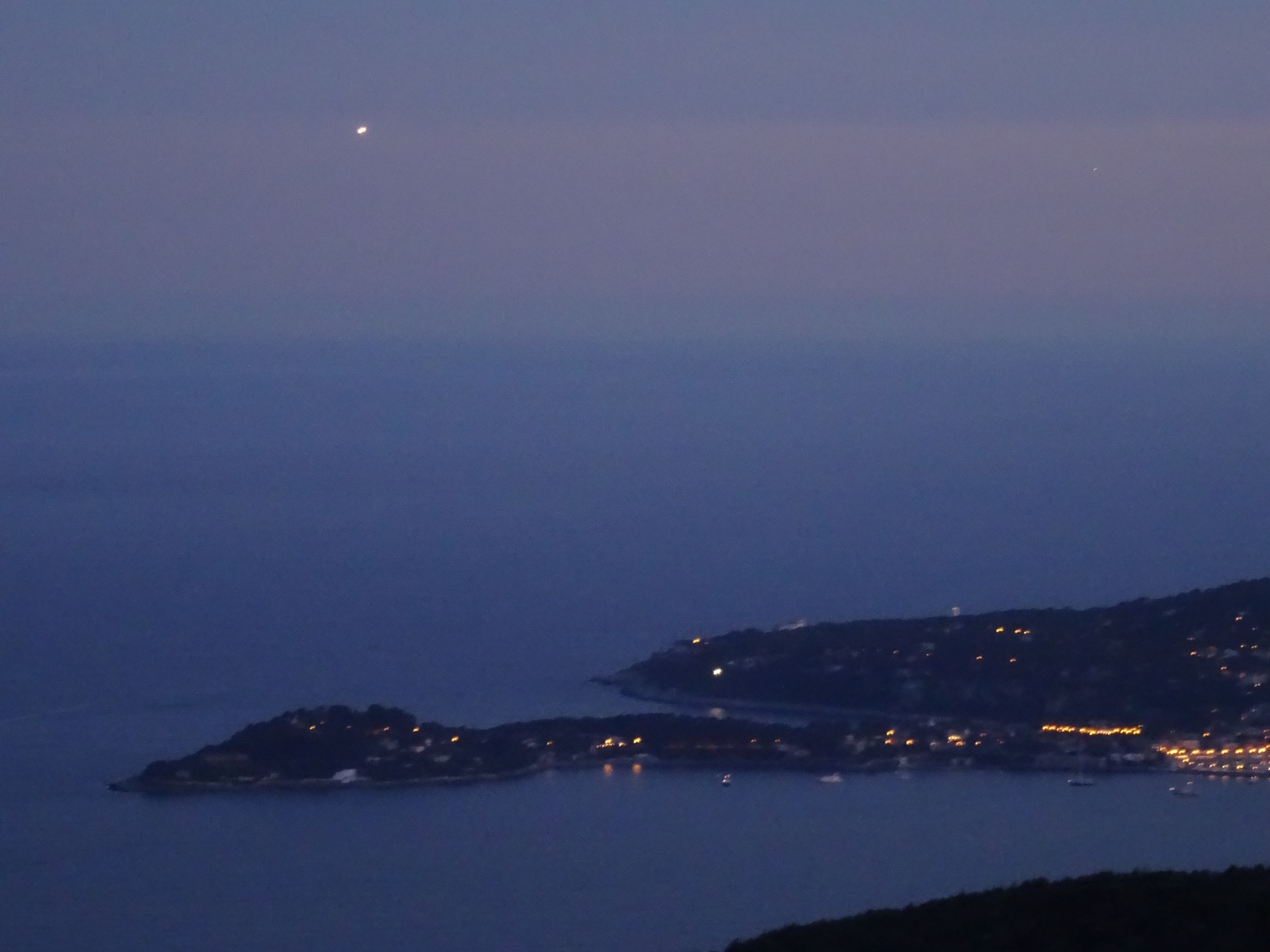
… is a commercial airplane on its way landing on an airport south France located exactly 22 miles away. The airplane itself is not visible, only landing lights are, yet it is far bigger than a parachute flare and the power of the landing lights* is similar to that of the LUU parachute flare.
The fact that the parachutes and the smoke trails are not visible is due to the impact of the Rayleigh scattering effect in the atmosphere that completely dilutes the diffuse reflexion of the light on the parachute and smoke surface, in the distance.
The closer the parachute flares are from the observer, the better are the chances for the parachute and smoke to be visible, like in some examples I’ve seen in this thread.
* For example, Honeywell produces a landing light for the B737-600/700/800 that uses a 600 Watt, Halogen Quartz bulb supplied by 115V 400Hz AC current. The drive is an induction motor and sealed spur gear drive with worm/sector final output. This light output is 750,000 candle power and has a maximum operating speed of 300kts
edit on 2-1-2018 by elevenaugust because: Add the Honeywell reference
originally posted by: elevenaugust
originally posted by: facedye
You honestly believe the flares would look that bright 20 miles away on a "low quality video tape camera from the early 90's"?
Yes, they would.
This is not because it is a “low quality camcorder” that he can’t capture bright and distant lights.
Usually, in the general sense, the definition of “low quality” refers to the image resolution and the compression factor; with a more or less poor rendering of the image (BTW this is clearly visible on the video where classic camcorder’s looks like artifacts are presents).
Neither the internal optic lens system nor the sensor takes part in the degradation of the light signal at the point that it might become invisible (for the lens system, it depends in fact of the optics transmission coefficient which do not dramatically change between lenses models, which main purpose is precisely to let the light comes in the better possible way to the sensor). Indeed, those two weren’t that bad for camcorders back in 1994 comparing to what we have nowadays; especially when you know that we are dealing here with very powerful lights, which puts out 1.6 million candelas for 5 minutes. (LUU-2B/B technical specifications in the 90’s, see references for the Phoenix incident here and here).
To give you a comparative example of the extreme power of the light produced by LUU parachute flare, 1.6 million candela is more than the 1 million candela produced by the halogen lamp inside the Cape Leeuwin lighthouse, with a range up to 25 nautical miles (28.8 miles).
originally posted by: facedye …you also believe that this kind of low quality camcorder would be able to capture lights like that 20 miles away, but not their smoke trails or parachutes?
No, it wouldn’t.
Smoke trails and parachutes are not as bright as the flares themselves (in fact much less) and at a 20 miles distance, no way they can be visible at naked eyes or by the camcorder.
This …
… is a commercial airplane on its way landing on an airport south France located exactly 22 miles away. The airplane itself is not visible, only landing lights are, yet it is far bigger than a parachute flare and the power of the landing lights* is similar to that of the LUU parachute flare.
The fact that the parachutes and the smoke trails are not visible is due to the impact of the Rayleigh scattering effect in the atmosphere that completely dilutes the diffuse reflexion of the light on the parachute and smoke surface, in the distance.
The closer the parachute flares are from the observer, the better are the chances for the parachute and smoke to be visible, like in some examples I’ve seen in this thread.
* For example, Honeywell produces a landing light for the B737-600/700/800 that uses a 600 Watt, Halogen Quartz bulb supplied by 115V 400Hz AC current. The drive is an induction motor and sealed spur gear drive with worm/sector final output. This light output is 750,000 candle power and has a maximum operating speed of 300kts
with all due respect, this is a really weak rebuttal. this "low quality camcorder" that we're talking about was able to capture lights *presumably* about 20 miles away with way more intensity and clarity than that HD photo you posted. this is pretty silly. why would you think that would be a good example? you're shooting your position in the foot.
also:
Smoke trails and parachutes are not as bright as the flares themselves (in fact much less) and at a 20 miles distance, no way they can be visible at naked eyes or by the camcorder.
you're wrong, and exaggerating. please watch this again, in totality. while it's not a "low quality 90's camcorder," the smoke is the only visible portion of this flare from a far off distance.
the smoke is clearly visible, even when the flare itself no longer is. i'm sorry, but there's really little to no merit in being convinced that these are flares in my OP. they truly don't compare.
EDIT:
For example, Honeywell produces a landing light for the B737-600/700/800 that uses a 600 Watt, Halogen Quartz bulb supplied by 115V 400Hz AC current. The drive is an induction motor and sealed spur gear drive with worm/sector final output. This light output is 750,000 candle power and has a maximum operating speed of 300kts
you're using a lightbulb as a comparison to a flare? when we're talking about obvious identifiers for flares like smoke, rate of fall and sometimes parachutes? this truly doesn't apply at all.
The closer the parachute flares are from the observer, the better are the chances for the parachute and smoke to be visible, like in some examples I’ve seen in this thread.
and in every single example i and other people have posted here, the smoke is always visible and lingering once the flare burns out.
edit on 2-1-2018 by facedye because: (no reason given)
originally posted by: facedye This "low quality camcorder" that we're talking about was able to capture lights *presumably* about 20 miles away with way more intensity and clarity than that HD photo you posted.
originally posted by: facedye You're using a lightbulb as a comparison to a flare? when we're talking about obvious identifiers for flares like smoke, rate of fall and sometimes parachutes? this truly doesn't apply at all.
Of course, the light bulb example was used with my airliner photo to show how it’s perfectly possible for a + 20 miles powerful parachute flare light to be visible and very bright.
The more or less bright aspect of the lights is not crucial and do not dismiss at all the parachute flare hypothesis that is still available, simply because the lights are visible; nonetheless, this more or less bright aspect depends of many others factors, such as:
- The use of the zoom that gives a visual impression of brighter lights. My photo example was taken using the zoom a few seconds after another, taken this time with no zoom:
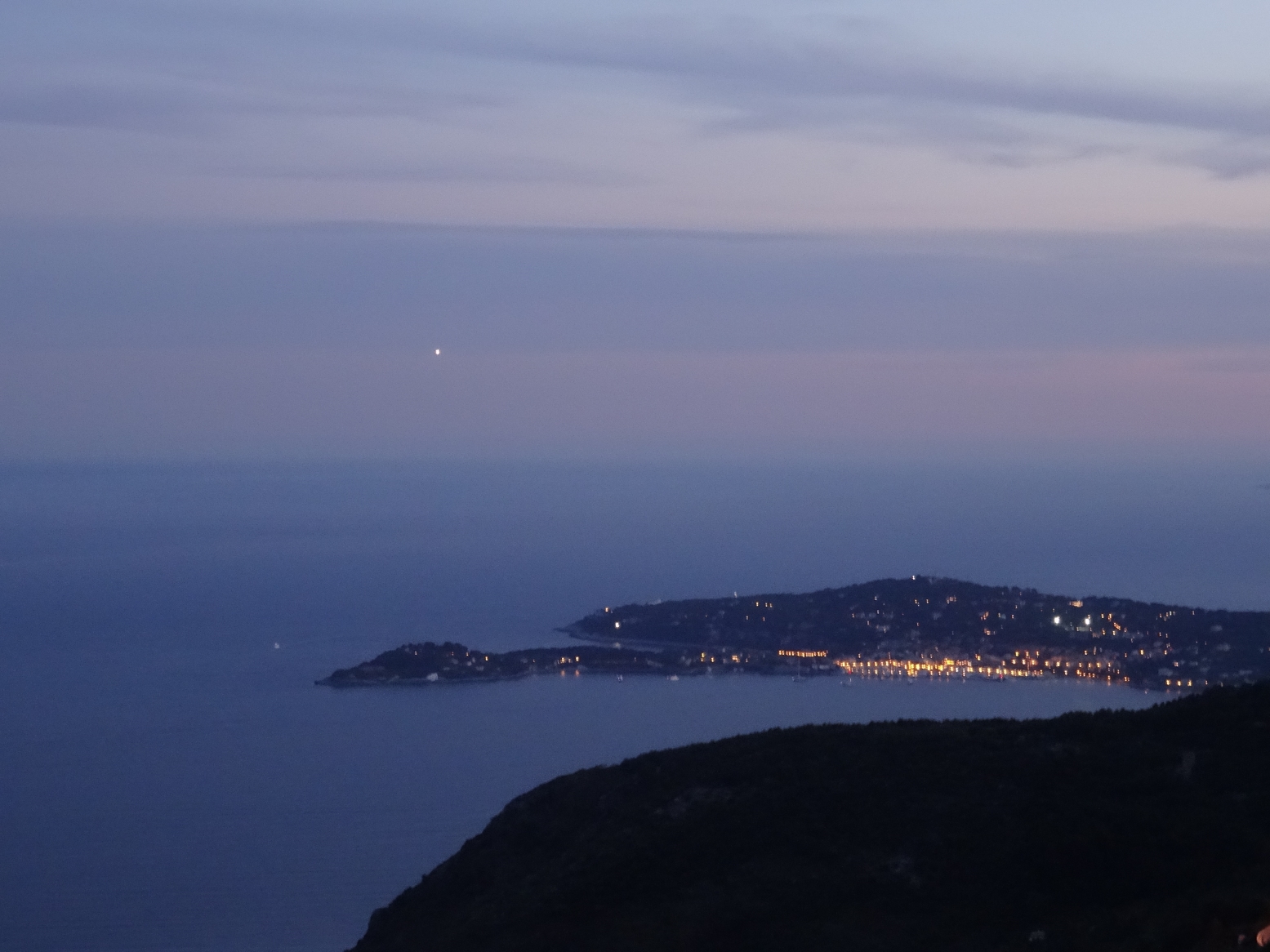
If you put side by side the two pictures, the left one (with zoom) looks “brighter” than the right one:
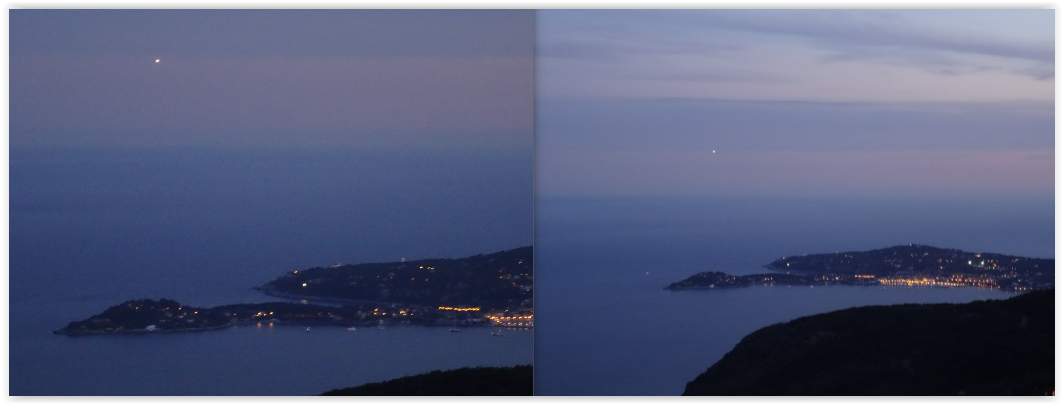
- The angle between the axis of the airliner’s movement vs the axis of the orientation of the camera. Indeed, if the airplane is not perfectly lined up in the direction of the camera, the landing lights will appear less bright. The greater this angle is, the lesser bright the lights will appear. It's quite possible in my example that the airliner do not lined up exactly with the camera axis.
- The technical parameters of the photos. The bright aspect of any light on a photo depends of a combination of some parameters, such as the ISO, the aperture value and the exposure time. For example, a same candle light taken at 1/90 s but with different aperture value will give this:
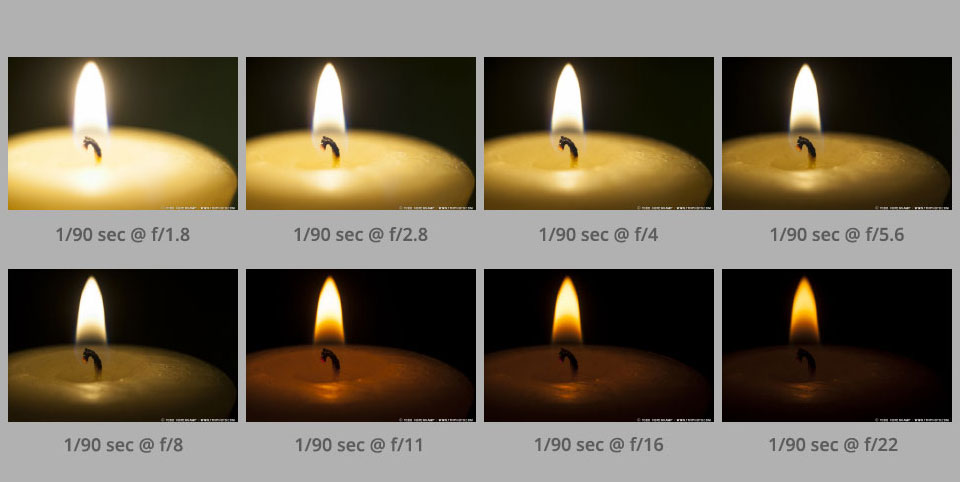
And if you do not change anything but ISO:
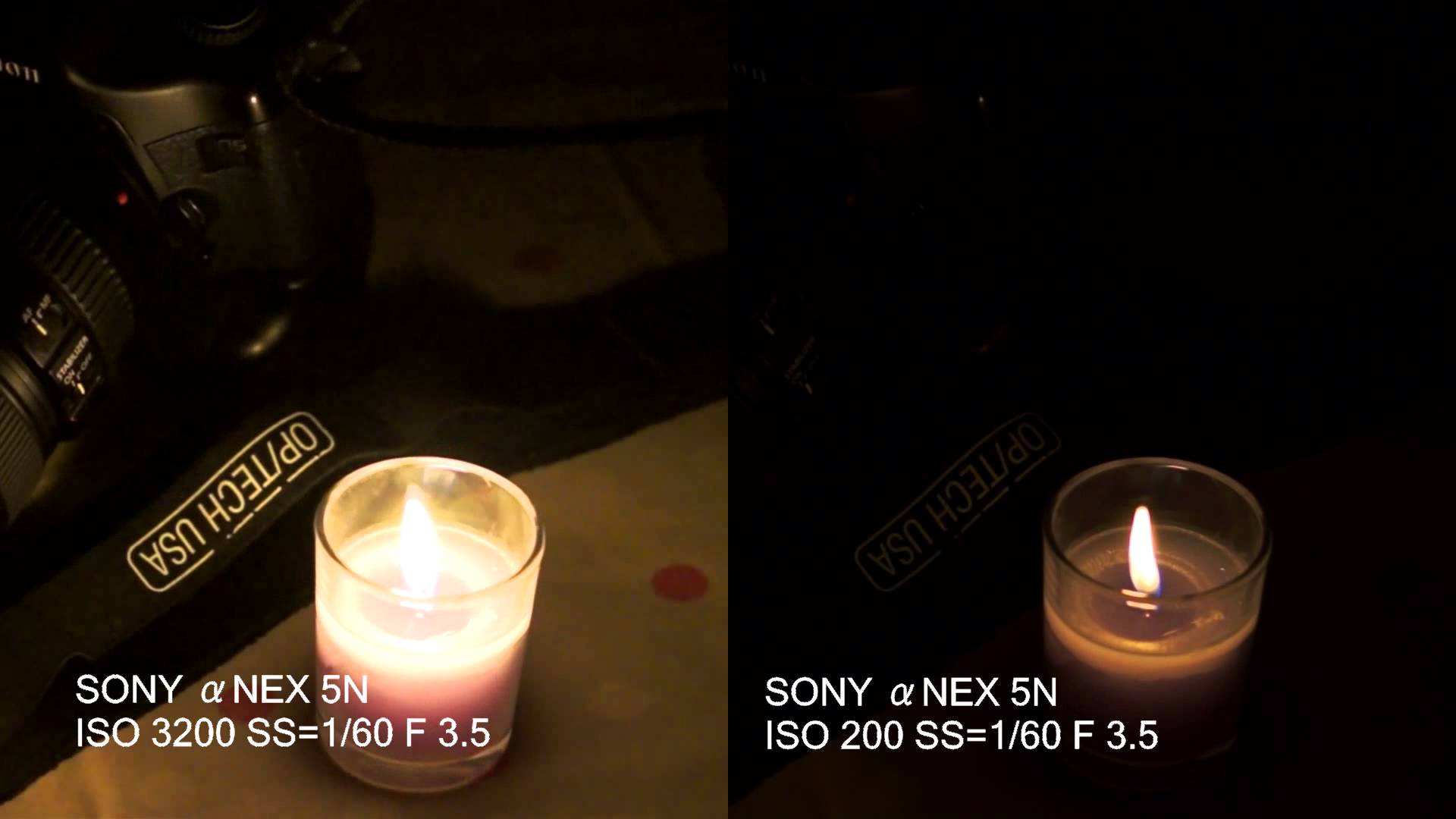
If my photos examples were taken with different parameters (greater ISO, aperture or exposure time), there's no doubts that the lights would looks like far more bright.
Also, a variation of the exact candela value of the landing light bulb might make some difference. I would roughly say that we are dealing with something comprised between 600.000 and one million candela, depending of the airplane and of the light bulb system used. All other things being equal, a 600.000 candela light bulb will be less bright than a one million candela light bulb.
originally posted by: facedye… the smoke is the only visible portion of this flare from a far off distance… The smoke is clearly visible, even when the flare itself no longer is.
There were three videos posted page 3 of this thread by “markymint” and in none of these the distance of the helicopter or of the jet is known. Moreover, at least for the daylight footages, none of them are parachute flare but instead decoy flares, for countermeasure purposes, which is not the same at all as ground illumination flare (for battlefield illumination purpose), equipped with parachute. These last longer (instead of a few seconds for decoy flares) and fall to the ground more slowly, thanks to the parachute, not present inside the decoy flare system.
The fourth video you posted page 4 “Yeovilton airday…” show the same decoy flares, from a very short distance, as we can clearly see the helicopters or the jets that release them.
The fifth video is more interesting as it indeed shows parachute flares. Unfortunately, we do not have any mention of the release distance, so no conclusion can be drawn from this video. All that can be said is that the closer to the camera they are released, the better are the chances to see the smoke trails and the parachute (BTW parachutes are not even visible here…).
The LLU-19 flare test video is the most interesting as were can clearly see both the parachute and the smoke trail. Unfortunately here again, we have zero information about the distance of the test. A rough estimation might be done anyway as at 0’57’’ as the airplane that release the flare tube can clearly be seen:
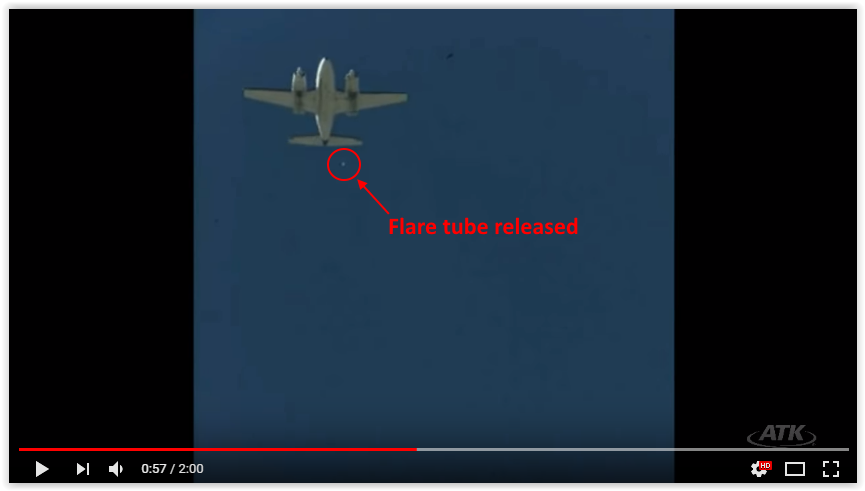
No way this small airplane is located 20 miles away from the camera. Would the same test done 20 miles away from the camera, at a lower angle above the horizon will show the parachute and the smoke trail? Certainly not.
Now, I’ll give you daylight examples of ground illumination flares in both situations, for the same military exercise, i-e seen in a “short” distance and in greater distances. This happened during June 2013 and involved many nations in what military called at that time “BALTOPS Exercise”.
The video (in polish) can be seen here.
Ground illumination flares as seen “close” to the camera:
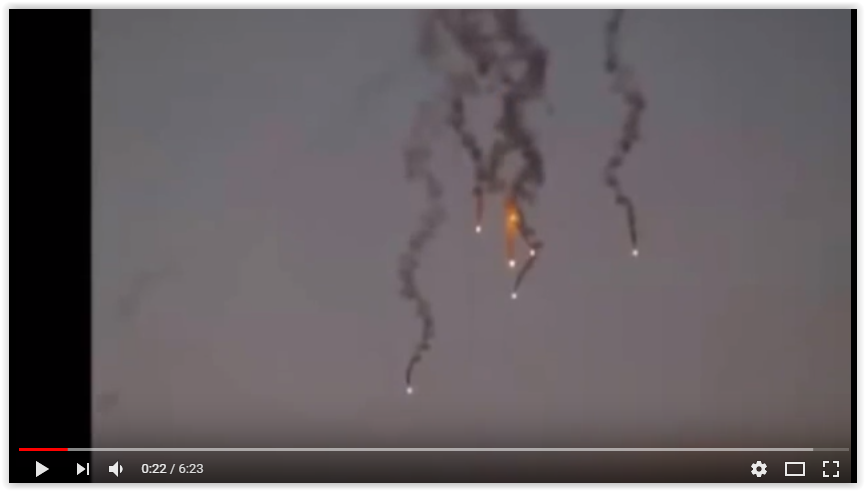
Now, a bit further away:
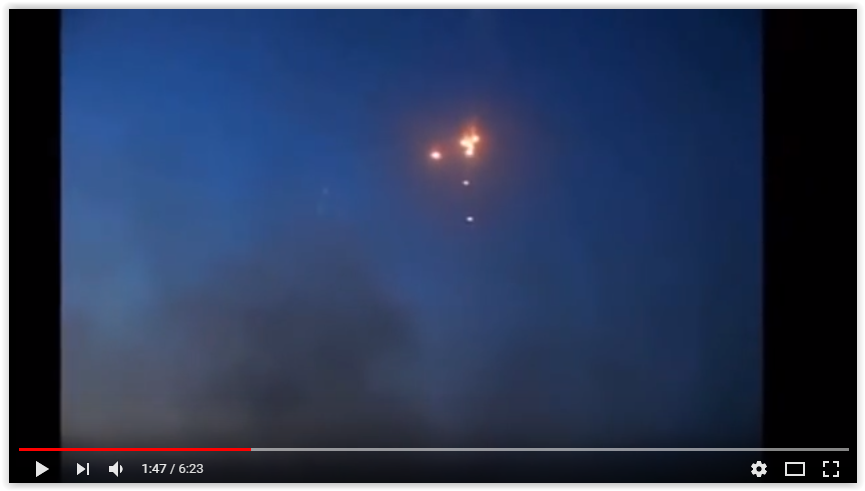
The smoke trails are hardly visible now.
As seen more far away:
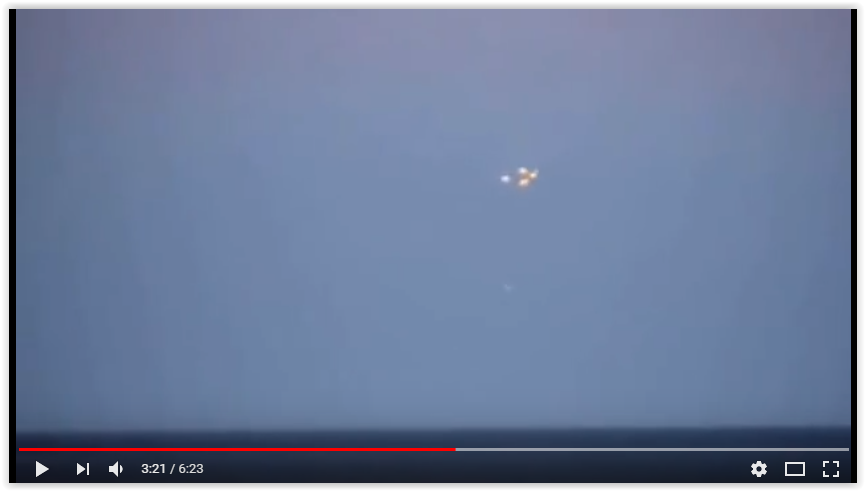
As it can be seen, the smoke trails are not anymore visible (we can also note that the parachutes are not visible at all, neither in the close capture, nor in the distant one).
Another example, by night:
“This is a Range-Lat spread where we fire 4 guns and time the fuzes so that the rounds function about 800 meters above the ground. The Illum rounds have 1 million candle watt power and each one lights up about 1000 square meters”.
The smoke trails are hardly, if not visible.
So I would say that the ground illumination flare hypothesis for this MUFON case is plausible. Not proven, but plausible.
edit on 2-1-2018 by
elevenaugust because: (no reason given)
a reply to: elevenaugust
no, it simply doesn't make sense.
the LUU-19 flare burns for 7 minutes, has a parachute, and is similar to the LUU-2 in most ways. watch the footage all the way through, and you can see how clear the smoke trail is when viewed from the ground, miles and miles away. know why this is important? because the fishermen were well within the kind of distance you would need to make that judgment.
and why would you start talking about the aperture and exposure time? within the same footage, you see them panning around to grab a shot of the sun setting in the horizon - the objects clearly shine brighter than the sun. this footage provides you references to compare the exposure and aperture, and you can definitely tell that these values were not exaggerated or muted enough to distort the captured images.
i've worked with digital video and film for years - you're grasping at straws.
ectoplasm is also misinterpreting the MUFON report, as his "20 mile away" sense of distance from the object is incorrect. this footage was taken from "20 miles offshore," not "20 miles from the object."
so by the same token, because you cannot gauge the correct distance from the fishermen to the objects, you cannot conclude that they're flares. this is nonsense, as you can clearly tell they're close enough to these BRIGHT objects in order to determine whether or not they're falling flares.
not only do these flares not resemble the UFO footage *at all*, but you can clearly see either the smoke trails or the entire cluster slowly falling in every point of distance you presented. nothing like this is present in the UFO footage.
if it's not proven, and merely plausible, then you should be able to easily accept the downfalls in your reasoning. you haven't presented anything in this thread that resembles the footage in my OP. funny enough, if it was that easy to determine, there'd be no reason to discuss it.
no, it simply doesn't make sense.
There were three videos posted page 3 of this thread by “markymint” and in none of these the distance of the helicopter or of the jet is known. Moreover, at least for the daylight footages, none of them are parachute flare but instead decoy flares, for countermeasure purposes, which is not the same at all as ground illumination flare (or battlefield illumination purpose), equipped with parachute. These last longer (instead of a few seconds for decoy flares) and fall to the ground more slowly, thanks to the parachute, not present inside the decoy flare system.
the LUU-19 flare burns for 7 minutes, has a parachute, and is similar to the LUU-2 in most ways. watch the footage all the way through, and you can see how clear the smoke trail is when viewed from the ground, miles and miles away. know why this is important? because the fishermen were well within the kind of distance you would need to make that judgment.
and why would you start talking about the aperture and exposure time? within the same footage, you see them panning around to grab a shot of the sun setting in the horizon - the objects clearly shine brighter than the sun. this footage provides you references to compare the exposure and aperture, and you can definitely tell that these values were not exaggerated or muted enough to distort the captured images.
i've worked with digital video and film for years - you're grasping at straws.
ectoplasm is also misinterpreting the MUFON report, as his "20 mile away" sense of distance from the object is incorrect. this footage was taken from "20 miles offshore," not "20 miles from the object."
The fifth video is more interesting as it indeed shows parachute flares. Unfortunately, we do not have any mention of the release distance, so no conclusion can be drawn from this video. All that can be said is that the closer to the camera they are released, the better are the chances to see the smoke trails and the parachute (BTW parachutes are not even visible here…). The LLU-19 flare test video is the most interesting as were can clearly see both the parachute and the smoke trail. Unfortunately here again, we have zero information about the distance of the test. A rough estimation might be done anyway as at 0’57’’ as the airplane that release the flare tube can clearly be seen:
so by the same token, because you cannot gauge the correct distance from the fishermen to the objects, you cannot conclude that they're flares. this is nonsense, as you can clearly tell they're close enough to these BRIGHT objects in order to determine whether or not they're falling flares.
Ground illumination flares as seen “close” to the camera:
not only do these flares not resemble the UFO footage *at all*, but you can clearly see either the smoke trails or the entire cluster slowly falling in every point of distance you presented. nothing like this is present in the UFO footage.
So I would say that the ground illumination flare hypothesis for this MUFON case is plausible. Not proven, but plausible.
if it's not proven, and merely plausible, then you should be able to easily accept the downfalls in your reasoning. you haven't presented anything in this thread that resembles the footage in my OP. funny enough, if it was that easy to determine, there'd be no reason to discuss it.
edit on
2-1-2018 by facedye because: (no reason given)
a reply to: facedye
VHS camcorder footage on youtube comment re the brightness compared to the sun you have heard of automatic exposure.
Exposure makes ALL the difference for example.
Is the paper black
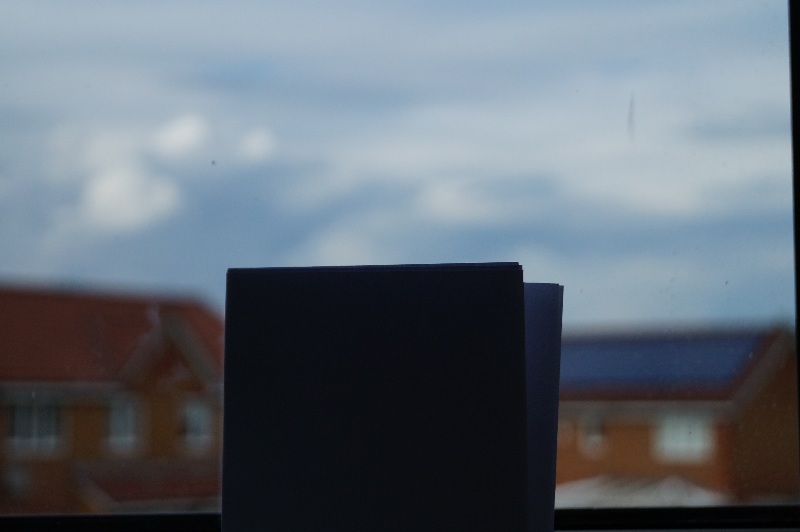
or is it white
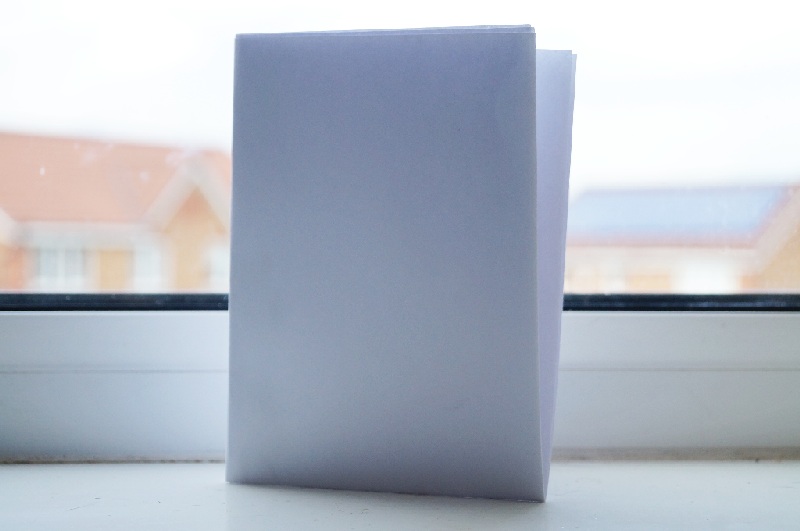
As for distance YOU have no way of telling how far those objects are away also if they are not focused correctly you can get issues like this.
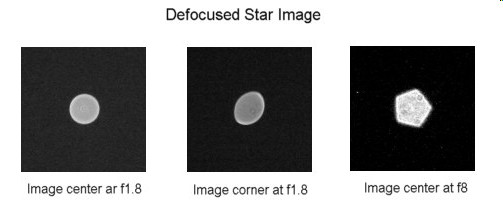
Best method for video or pictures in low light levels is manual everything.
Unless of course you have something like this.
If you watched that video you would have seen examples that I have mentioned above, also consider this many of us on here are long time amatuer photographers we even have a few professionals many have been taking pictures way longer than some members have been alive and know the pitfalls and assumtions people can make.
VHS camcorder footage on youtube comment re the brightness compared to the sun you have heard of automatic exposure.
Exposure makes ALL the difference for example.
Is the paper black

or is it white

As for distance YOU have no way of telling how far those objects are away also if they are not focused correctly you can get issues like this.

Best method for video or pictures in low light levels is manual everything.
Unless of course you have something like this.
If you watched that video you would have seen examples that I have mentioned above, also consider this many of us on here are long time amatuer photographers we even have a few professionals many have been taking pictures way longer than some members have been alive and know the pitfalls and assumtions people can make.
originally posted by: facedye
... the fishermen were well within the kind of distance you would need to make that judgment.
originally posted by: facedye
...because you cannot gauge the correct distance from the fishermen to the objects, you cannot conclude that they're flares. This is nonsense, as you can clearly tell they're close enough to these BRIGHT objects in order to determine whether or not they're falling flares.
Where does the idea that these lights have to be close to the fishermen comes?
There’s nothing concrete that exist in support of this idea, only a “visual impression” that cannot be taken as valuable.
Indeed, any estimation of distance is doubtful, especially where only lights are visible; with no others reference landscape points.
Then, there’s nothing that discard the idea that they might be further away, rendering thus credible the parachute flare hypothesis.
in other words, since you have absolutely no concrete data about the distance between the fishermen and the lights, these could very well be more far away than those in your video example, thus making the smoke trails not visible anymore, as it can be seen in the Polish video I took in example that perfectly show how distance play a key role in the visibility of the parachute and smoke trails.
originally posted by: facedye
and why would you start talking about the aperture and exposure time?
It was in reply to your comment saying “this “low quality camcorder” that we’re talking about was able to capture lights “presumably” about 20 miles away with way more intensity and clarity than that HD photo you posted”.
If the lights in the video appear to be more intense than that in my photo example, it’s not necessarily because they really are (i-e per se) more intense. Indeed, camera settings play a decisive role in the bright appearance of the landing light of the airplane in my photo example, as we can visually perceive it. Changing these settings (increasing the ISO or the aperture value for example), will have for result to artificially increase the brightness of the lights in the photo, then making it appears more intense to the naked eyes.
Don’t forget also all the others points I’ve made in my previous post that complete how and why there are difference in the apparent brightness of the landing lights. In respect of the MUFON video, all my points explain why a distant bright light can be visible and not the “surroundings”, i-e the airliner or the smoke trails, by themselves.
originally posted by: facedye
Within the same footage, you see them panning around to grab a shot of the sun setting in the horizon - the objects clearly shine brighter than the sun.
It might be true… or not. Indeed, this evaluation is rather subjective and depends of many factors, the main one being the visual perception of the person that compares the luminosity of the sun and of the objects.
For this to be more objective, you’ll have to extract one frame of the video where the sun is visible, and another frame, at the same zoom level, where the objects are visible. Then you’ll have to compare the lightened area in radiometric terms.
Anyway, a visual evaluation, as you have done it, can better be evaluated by comparing side by side the two frames captures.
It’s hard to define what the zoom level was and then to find a frame for the object at the same zoom level as that of the sun, but let’s take a frame at max zoom level for the object, it doesn’t make much difference in the end.
Sun's frame:
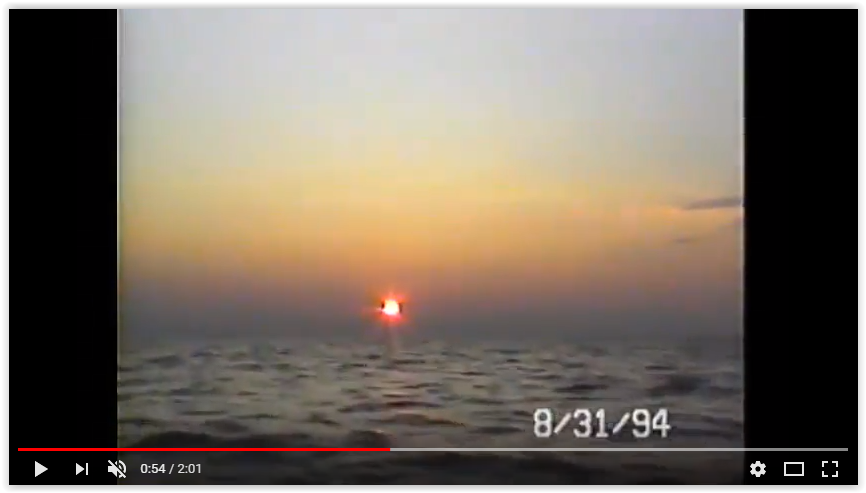
Object’s frame:
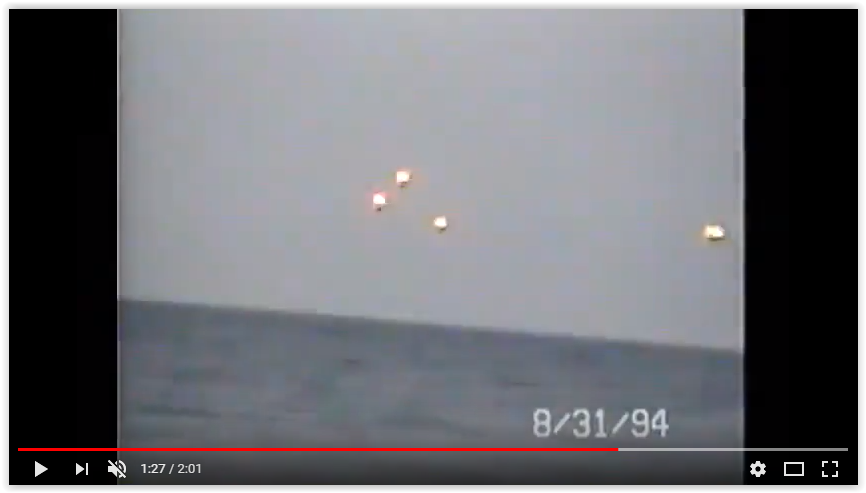
Side by side comparison:
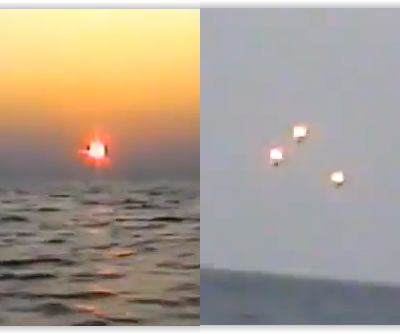
Which one is brighter? I’d curious to have others ATSers opinion.
Anyway, whether the sun is brighter than the objects does not discard the validity of the parachute flare hypothesis. A 1.6 million candela light is very bright and there no doubts that it can be visible several tens of miles away.
originally posted by: facedye
ectoplasm is also misinterpreting the MUFON report, as his "20 mile away" sense of distance from the object is incorrect. This footage was taken from "20 miles offshore," not "20 miles from the object."
This does not change the fact that, in the case of parachute flare with such powerful light (we are talking about 1.6 million candela), there’s no problem, further away than 20 miles, for the light to be observed.
In my photo example, you have a 600.000/1 million candela light visible 22 miles away, so there’s absolutely no problem to see a 1.6 million candela at that same distance and even further away.
At that distance, you can’t expect to see the smoke trails and the parachutes.
originally posted by: facedye
…you can clearly see either the smoke trails or the entire cluster slowly falling in every point of distance you presented. Nothing like this is present in the UFO footage.
Of course, as you only take the first part of my example, where the parachute flares are the closest to the camera.
If you take the third capture of my example where the parachutes flares are the farthest, you do not see the smoke trails anymore.
In fact, it’s rather simple. In the parachute flare hypothesis, you have a very powerful light that can be visible several tens miles away, and at that distance the smoke trails cannot be visible anymore, as I’ve shown it in several examples.
edit on 3-1-2018 by elevenaugust because: (no
reason given)
new topics
-
Happy Thanksgiving to ATS
General Chit Chat: 1 hours ago -
Simple Thanksgiving
Food and Cooking: 8 hours ago -
Trump could make a peaceful American Revolution
US Political Madness: 11 hours ago -
Trump Presidential Transition Team will not use GSA or Government entities to come to DC
US Political Madness: 11 hours ago
top topics
-
V.P. Kamala Harris releases a video and nobody understands why
US Political Madness: 16 hours ago, 16 flags -
Mind Blowing Cave under someones land
Fragile Earth: 12 hours ago, 16 flags -
The Party of Peace - Trump Cabinet Picks Targeted with Death Threats
US Political Madness: 13 hours ago, 15 flags -
Trump could make a peaceful American Revolution
US Political Madness: 11 hours ago, 14 flags -
Trump Presidential Transition Team will not use GSA or Government entities to come to DC
US Political Madness: 11 hours ago, 13 flags -
Simple Thanksgiving
Food and Cooking: 8 hours ago, 13 flags -
Happy Thanksgiving to ATS
General Chit Chat: 1 hours ago, 3 flags
active topics
-
Simple Thanksgiving
Food and Cooking • 27 • : Owlwatcher -
Mind Blowing Cave under someones land
Fragile Earth • 17 • : Owlwatcher -
Happy Thanksgiving to ATS
General Chit Chat • 2 • : GENERAL EYES -
Trump Presidential Transition Team will not use GSA or Government entities to come to DC
US Political Madness • 12 • : 777Vader -
The Party of Peace - Trump Cabinet Picks Targeted with Death Threats
US Political Madness • 27 • : DBCowboy -
President-Elect DONALD TRUMP's 2nd-Term Administration Takes Shape.
Political Ideology • 256 • : WeMustCare -
-@TH3WH17ERABB17- -Q- ---TIME TO SHOW THE WORLD--- -Part- --44--
Dissecting Disinformation • 3389 • : Crazierfox -
I thought Trump was the existential threat?
World War Three • 113 • : WeMustCare -
Mood Music Part VI
Music • 3719 • : MRTrismegistus -
Tunnels of Terror: The Cryptid Connection The Why Files
Cryptozoology • 5 • : TheMisguidedAngel
